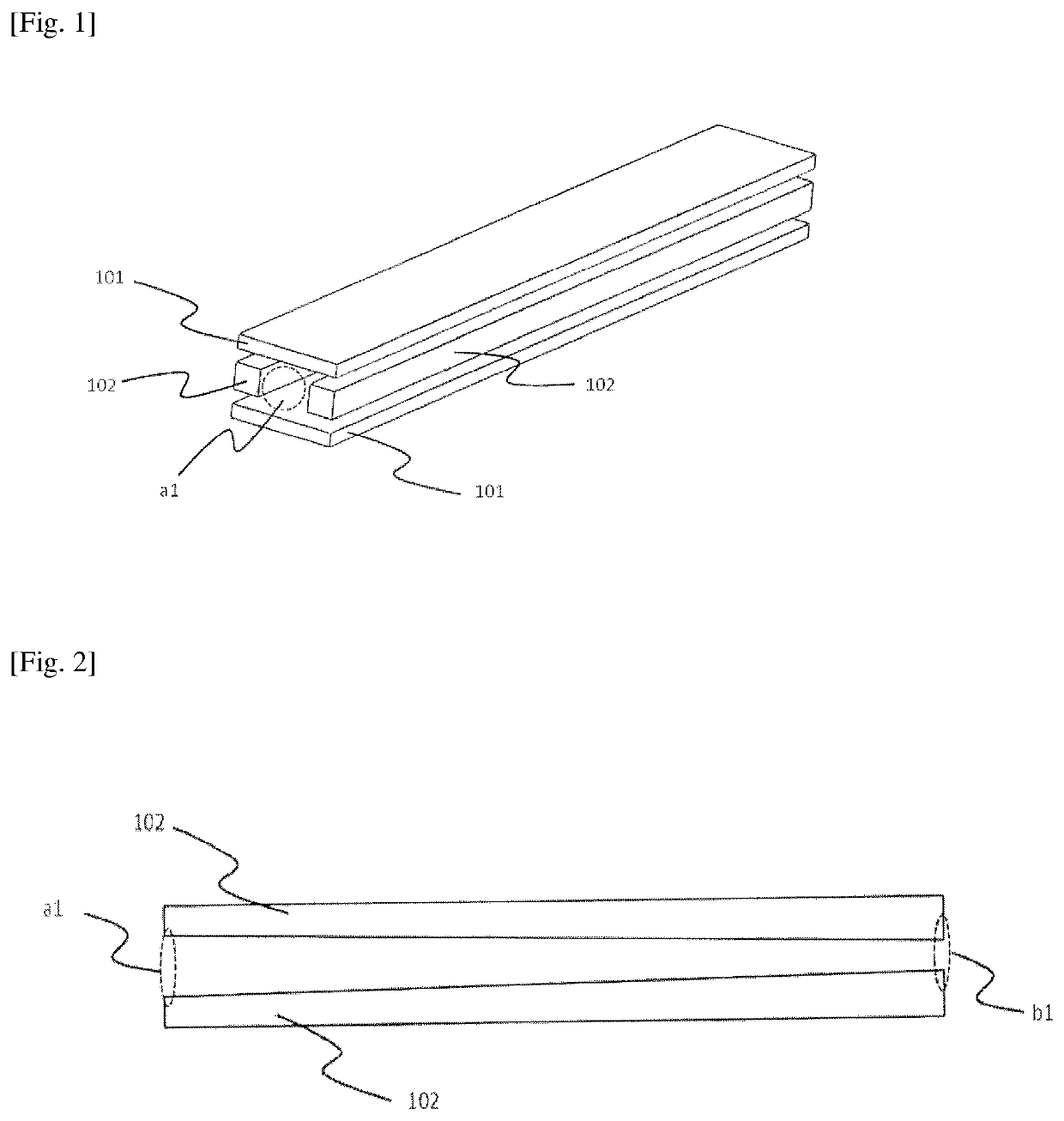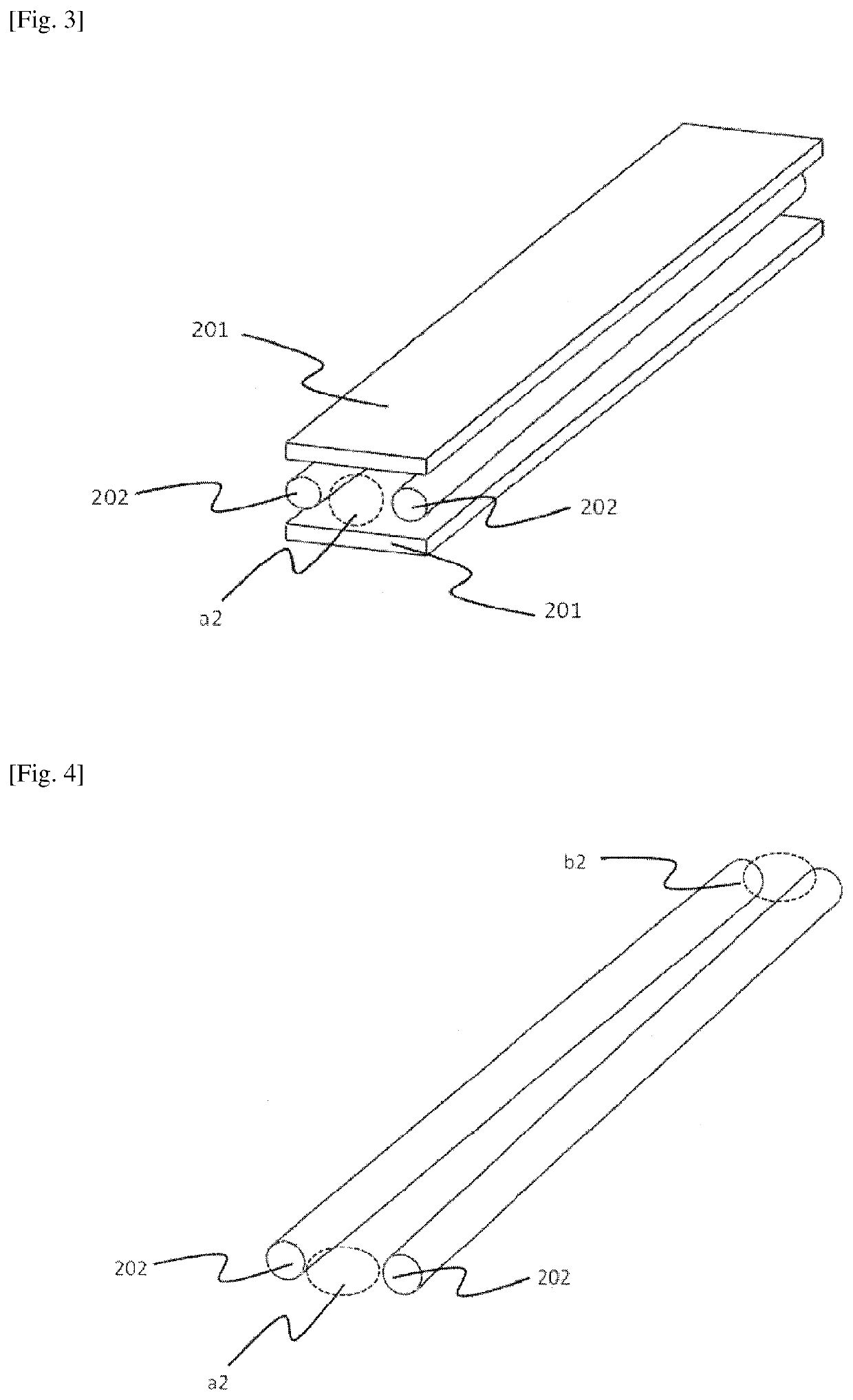Ion guiding device and related method
a technology of guiding device and guiding method, which is applied in the direction of electric discharge tube particle separator tube details, etc., can solve the problems of reducing the sensitivity of instruments, axial transmission of ions, and ion guiding device takes a long period of time to pass through, so as to achieve effective ion transmission speed and reduce overall length of instruments, the effect of increasing the signal-to-noise ratio of the guiding devi
- Summary
- Abstract
- Description
- Claims
- Application Information
AI Technical Summary
Benefits of technology
Problems solved by technology
Method used
Image
Examples
embodiment 1
[0064]As shown in FIG. 1, in Embodiment 1, the ion guiding device is of a linear structure, including a first electrode assembly 101, a second electrode assembly 102 and a power supply device (not shown). Wherein, the first electrode assembly 101 includes a pair of parallel electrode units arranged along a spatial axis, and the second electrode assembly 102 includes at least two non-parallel electrode units arranged in a parallel plane between the parallel electrode units along the spatial axis. Hence, the first electrode assembly 101 and the second electrode assembly 102 form an ion transmission channel along the spatial axis, with a larger ion inlet a1 and a smaller ion outlet b1, as shown in FIG. 2. In this embodiment, as the second electrode assembly 102, square rod electrodes or plate electrodes are used, and the second electrode assembly 102 has a rectangular cross-section.
[0065]The power supply device applies RF voltages with the same amplitude and frequency and opposite pola...
embodiment 2
[0070]As shown in FIGS. 3 and 4, a main difference between the ion guiding device in Embodiment 2 and the ion guiding device in Embodiment 1 lies in that, as the second electrode assembly 202, round rod electrodes are used. The implementation of the RF voltages and the DC voltages in this embodiment is basically same as that in Embodiment 1. The advantage of using round rod electrodes is that the field form of the quadrupole field is better, so it is advantageous for confining ions in the directions perpendicular to the spatial axis. Similarly, since the ion transmission channel has a larger ion inlet a2 and a smaller ion outlet b2, a large ion acceptance area is obtained, and the focusing effect of the ions is also excellent.
[0071]It is to be noted that, as the first electrode assembly 202, round rod electrodes may also be used to further improve its performance. However, the processing difficulty will be increased.
embodiment 3
[0072]The spatial axis may be a straight axis, a curved axis or a combination thereof. As shown in FIG. 5, in Embodiment 3, the spatial axis of the ion guiding device of the present invention is a curved axis of 180 degrees. Wherein, as the first electrode assembly 301, curved plate electrodes of 180 degrees are used. As shown in FIG. 6, the second electrode assembly 302 includes two arc electrode units which are bent 180 degrees. The two arc electrode units are not of a coaxial structure, and the spacing between the two arc electrode units decreases gradually from an ion inlet a3 to an ion outlet b3 in the direction of the spatial axis. Therefore, the cross-sectional area of the ion transmission channel formed in the curved ion guiding device also changes in the direction of the spatial axis. After the RF voltages and DC voltages are applied in a way similar to that in Embodiment 1, a RF electric field perpendicular to the spatial axis may also be formed to confine ions, and an axi...
PUM
 Login to View More
Login to View More Abstract
Description
Claims
Application Information
 Login to View More
Login to View More - R&D
- Intellectual Property
- Life Sciences
- Materials
- Tech Scout
- Unparalleled Data Quality
- Higher Quality Content
- 60% Fewer Hallucinations
Browse by: Latest US Patents, China's latest patents, Technical Efficacy Thesaurus, Application Domain, Technology Topic, Popular Technical Reports.
© 2025 PatSnap. All rights reserved.Legal|Privacy policy|Modern Slavery Act Transparency Statement|Sitemap|About US| Contact US: help@patsnap.com



